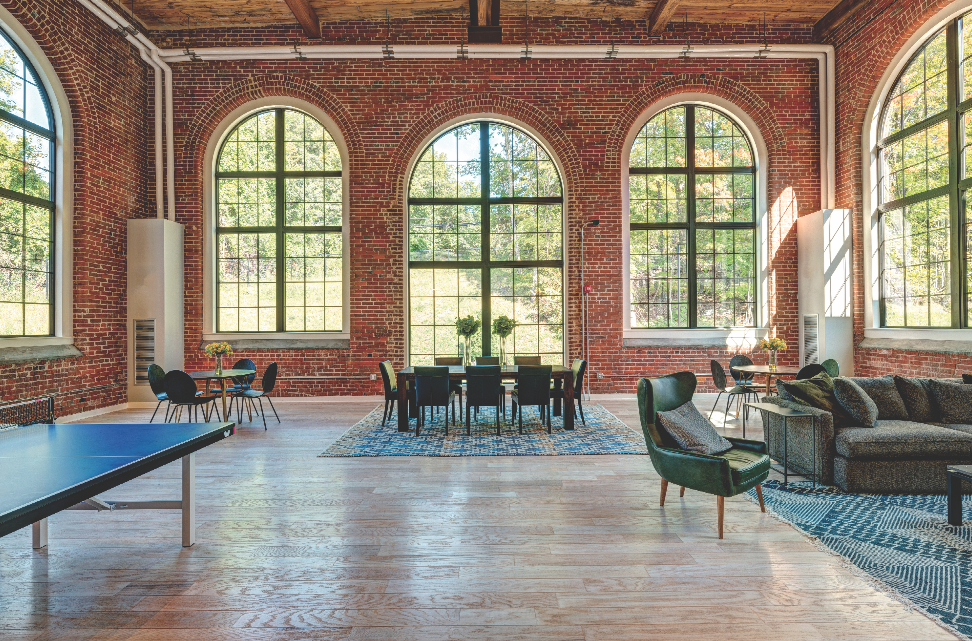Many small New England cities have a legacy of prominent early 20th-century brick mills that were built when industries like textiles, shoes, clocks, and machine parts thrived in the region.
These solid industrial buildings were built to last. Even after decades of neglect, with the right plan, design, and execution, they can become highly desirable living places.
Such is the case with two Massachusetts mill-to-apartment adaptations in Fitchburg and Ludlow. Both were designed by The Architectural Team (TAT), Boston, and developed by WinnDevelopment, the largest manager of affordable housing in the U.S., with 100,000 units in 22 states. Both projects showcase endearing early 20th-century elements—brick walls, old-growth wood beams, and steel staircases—while adding modern treatments and amenities that 21st-century multifamily tenants expect.
Yarn Works: Revitalizing Fitchburg
Located in north-central Massachusetts, Fitchburg has struggled economically for decades, but a commuter rail line connecting to Boston’s North Station—a 70-minute ride—and relatively affordable real estate may signal that a revival could be within its grasp.
The $24.2 million renovation of Yarn Works, a 182,500-sf vintage textile mill, is a step in that direction. Listed on the National Register of Historic Places, the three-story property, once known as the Nockege River Mill Building, offers 57 market-rate and 39 affordable loft homes. The mill sits on the banks of the Nashua River, just a mile from the city center.
The riverside provides a delightful network of walking trails and park space, but it also carries the threat of flooding. The Yarn Works property is in a 100-year flood zone, according to recent FEMA flood hazard mapping. Mitigating this risk was one of the chief environmental concerns faced by the project team, said TAT Project Manager Scott Maenpaa.

Nearly 300 8x12-foot steel sash-and-wood windows were replaced. New, thermally broken aluminum frames with historically matched muntins and divided-lite windows were installed to meet NPS standards. Photo: © Andy Ryan
Originally, water from the river was allowed to flow through the mill’s earthen basement, a situation that had to be rectified. The team’s initial option—filling in the crawlspace—was rejected because the crawlspace was part of the flood storage capacity on site. “If we were to fill it in, we would have had to create equal water storage capacity on site to offset it,” said Maenpaa. The solution devised by TAT, structural engineer ODEH Engineers, and GC Colantonio Inc.: raise the first floor about 27 inches using a steel and concrete deck.
The generous height of each floor (about 15 feet) and the placement of the large windows averted a potential major problem. After the floor was raised, a two-inch gap remained below the windows. Had the floor been raised even a few inches higher, it would have required altering the window dimensions or configuration, something that would have complicated adherence to historic standards.
With historic tax credits at stake, the National Park Service and state and local preservation agencies scrutinized the design plans to ensure that all exterior elements hewed closely to the original design. The existing 12-foot-high, eight-foot-wide wood windows were replaced with aluminum-frame windows that were sturdy enough to hold up to expected wind loads under current code. The aluminum windows’ thermally broken frames and brick molds, divided lite configurations, and historically matched muntins conformed to the old look, allowing them to pass muster with the Park Service.
The quest for historic accuracy went as far as an analysis of the mortar composition—aggregate, consistency, and color—to match the original recipe as closely as possible. Skilled masons replicated the concrete formula during an extensive repointing of brick walls to match the color and texture of the new mortar to the original.
Interior brick walls had been painted numerous times over the years. “Our vision for the interior, though, was to showcase the natural look of red brick and old-growth southern pine beams and columns,” said Maenpaa. The brick was delicately sandblasted to remove the lead paint. “It had to be done so that the brick would not be pitted,” Maenpaa said.
The existing wood floors were in poor condition and could not be saved. While covering them with hardwood would have met aesthetic and cost goals, that option was rejected for acoustic reasons. The exposed masonry and large windows, while gorgeous to look at, had little sound-absorbing qualities. This created an echo chamber that would have been made worse by hardwood, Maenpaa said. Sound-dampening attributes were added to the flooring system to prevent noise from walking and other normal activities from creating a din.
The design also called for leaving exposed the existing wood decking ceiling rather than installing a drop ceiling. That meant that the flooring had to provide all of the sound dampening between floors. A sound-absorbing mat (in this case, Quiet Qurl, from Keene Building Products), coupled with a gypsum floor underlayment (Maxxon’s Gypcrete), provided an effective sound (and odor) barrier.
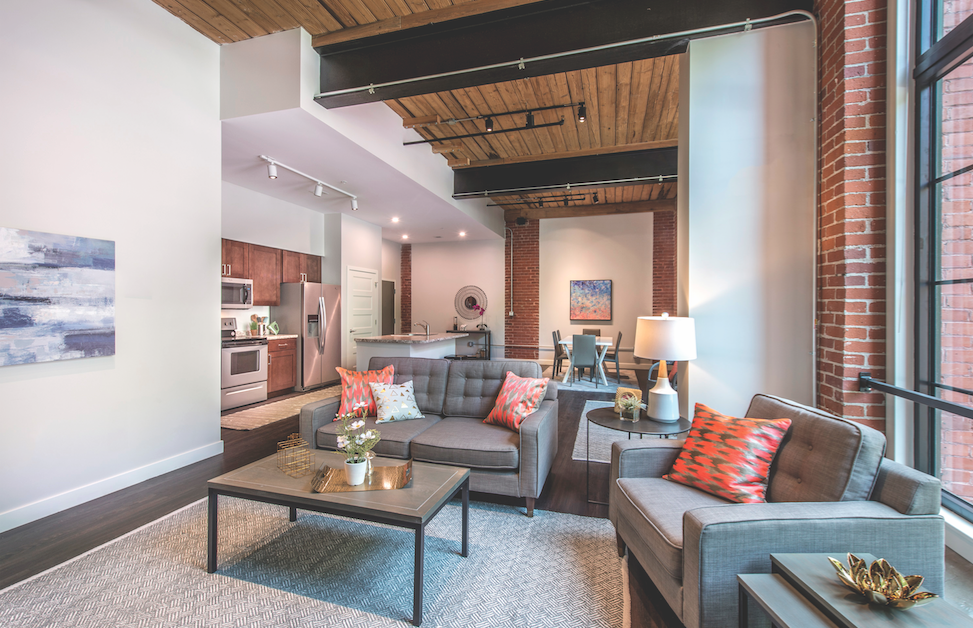
All 57 market-rate and 39 affordable loft homes at Yarn Works offer wood-plank ceilings and floors, exposed brick and original beams, and ceiling heights up to 15 feet. The $24.2 million renovation provided 29 one-bedroom, 58 two-bedroom, and nine three-bedroom apartments. Photo: © Gregg Shupe
Luxury vinyl plank flooring (from Turnaround Solutions) that mimics wood provided additional sound dampening and visually complemented the wood of the exposed ceiling deck. Hardwood flooring covers the common areas.
Many choices on interior finishes were set out by guidelines from the project’s funding agencies. These included high-grade laminate Formica 180fx countertops that mimic granite. In order to foster a clean indoor air environment, no carpeting was used. Low-VOC adhesives and no-VOC paints were specified. The cabinetry contained no urea formaldehyde products. Finishings were purposely kept minimal to reduce maintenance and expose the building’s architectural and structural elements.
The Massachusetts energy code requires a blower door test on each unit for buildings higher than three stories. To prevent air leakage, the units had to be compartmentalized from each other. (The layer of Gypcrete below the floor helped as well.) Exposed brick preserves the historic look and feel in the living room area walls. Bedrooms were insulated with closed-cell, high-density spray foam to enhance thermal efficiency. “About 40% of the walls in the building are insulated,” Maenpaa said.
The 3,000-sf lounge, which basks in the light of 17-foot-tall windows, has a community kitchen and a large-screen TV and seating area. (The kitchen countertop was crafted from Silestone, a quartz-like solid surface from Cosentino.) The dramatic space is defined by structural steel trusses, exposed brick walls, and 10-foot-high windows.
The Residences at Mill 10: Ludlow Rising
Just a short drive from Springfield, the Residences at Mill 10 are located in a 170-acre site along the Chicopee River, in Ludlow. The mill is one of more than 60 structures—including worker housing, schools, banks, and stores—built by the Ludlow Manufacturing and Sales Company, which over the course of 137 years produced jute yarns, rope, twine, and webbing. At its peak in the 1920s, the Ludlow complex occupied 1.2 million sf of mill and warehouse space.
The historic structure is a key element of the city’s Ludlow Mills Preservation and Redevelopment Master Plan. The four-story, 108,163-sf brick building, built in 1907, has much in common with the Yarn Works. It, too, is listed on the National Register of Historic Places; it, too, needed much of the same restoration work as the Fitchburg property—sandblasting and repointing the masonry, adding sound absorption to the flooring, and replacing more than 280 single-pane windows with double-pane aluminum historic replicas.
A significant difference in Ludlow was a large loading dock area in the rear of the first floor. Some of the first-floor units were expanded into this area, making them about twice the size of those in the floors above. “A lot of residents who moved in downsized from single-family homes, so these units offered extra space to make the move easier,” said Robert J. Verrier, FAIA, NCARB, TAT’s President, Managing Principal, and Founder. The bigger units have room for a formal dining area.
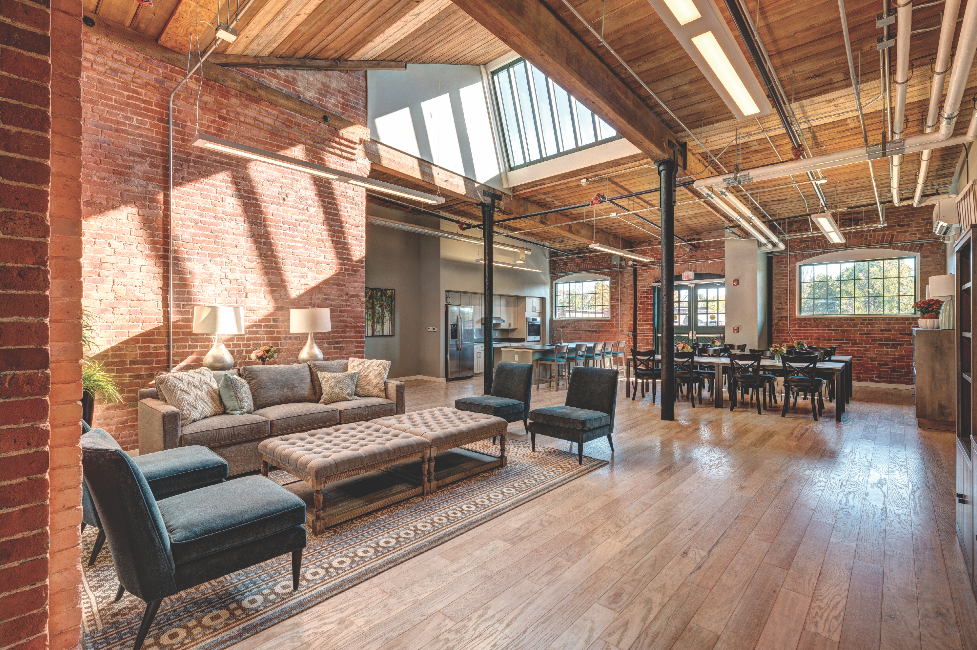
For the Residences at Mill 10 the renovation of the 108,000-sf former industrial facility required top-to-bottom structural work and restoration of the masonry façade. Exposed beams, high ceilings, and new historically matched windows characterize the interiors of the restored 1907-era mill, which is listed on the National Register of Historic Places. Photo: © Andy Ryan
The Ludlow property has a tenant lounge with a kitchen and TV viewing area on the first floor in the former loading dock area. Sawtooth skylights were preserved, allowing plenty of daylight to stream in. An outdoor patio provides additional seating off of the tenant lounge. There’s a fitness center and book nook, too.
The building’s main stair tower, a prominent feature at the main entrance, held up well over the years. “You could tell that it was the main point of egress for hundreds of mill workers,” Maenpaa said. “The treads had been worn down by as much as an inch.”
Planks salvaged from another century-old mill were used to replace the treads. The rails were cleaned and given a clear coat, leaving the refurbished staircase looking much as it had a hundred years ago.
A footbridge between the building and a neighboring structure was too low for modern fire equipment to pass under. But as part of the original structure it fell under historic review. “We had to bring a letter from the fire department to the National Park Service so that they would allow us to remove the bridge,” Maenpaa said.
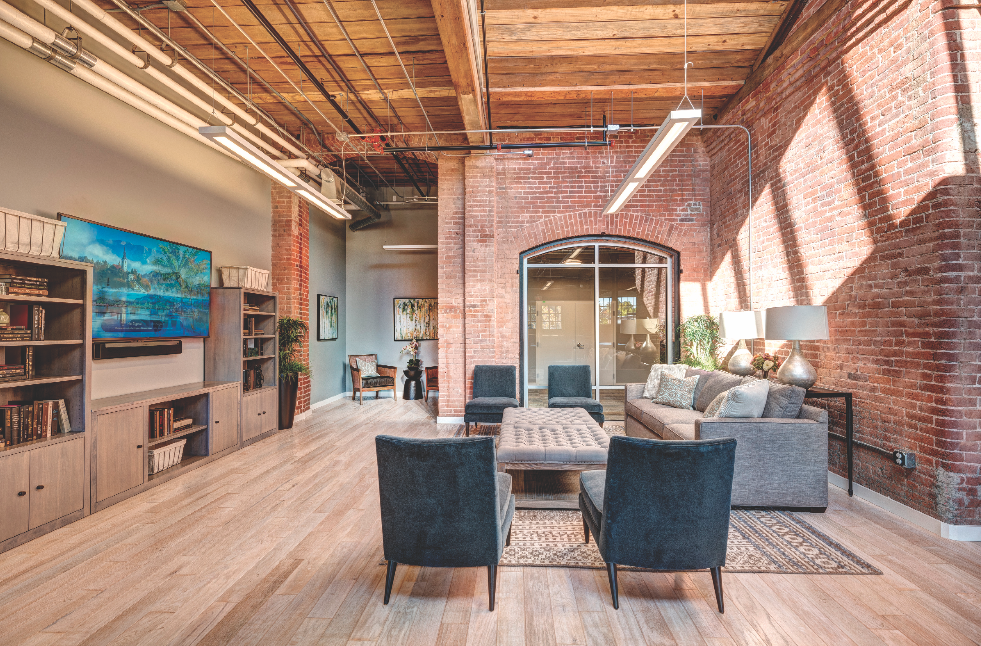
Amenities at the Residences at Mill 10 include community spaces and common areas on each of its four floors, a reading nook, a fitnes and yoga center, and a cybercafé lounge. Photo: © Andy Ryan
Once the bridge was demolished, a new stair tower, consisting of floor-to-ceiling glass and Castle Gray–colored metal panels, was constructed to provide additional egress.
The 63 one-bedroom and 12 two-bedroom units at the Residences at Mill 10 leased up in a flash. “There’s no doubt that the desire for quality housing for seniors in this region is strong,” said Lawrence H. Curtis, WinnDevelopment’s President and Managing Partner.
DOUBLING DOWN ON BENEFITS
The Yarn Works and the Residences at Mill 10 show how to bring century-old, architecturally intriguing structures up to modern code. Both buildings underwent seismic upgrades. Structural engineer ODEH Engineers added long spans of structural steel on the interior corners of the buildings to act as seismic ties. From both an environmental and economic perspective, they have achieved the best possible solution: saving two valuable historic edifices from the wrecking ball.
And there’s more to come. WinnDevelopment, which has completed more than 20 mill renovations across New England, has secured the rights to create up to 136 market-rate apartments, as well as commercial, retail, and office space, in the adjacent 231,000-sf Mill 8, known as the Clock Tower building.
PROJECT TEAM | YARN WORKS
Client: WinnDevelopment; Architect: The Architectural Team; Structural engineer: ODEH Engineers; General contractor: Colantonio, Inc.
PROJECT TEAM | THE RESIDENCES AT MILL 10
Client: WinnDevelopment; Architect: The Architectural Team; General contractor: Dellbrook Construction
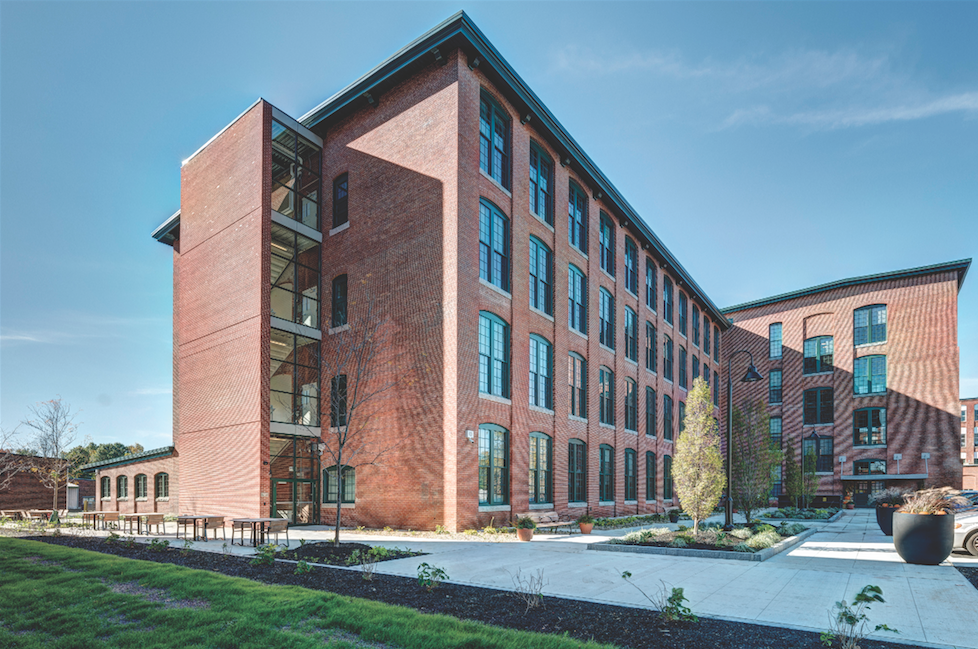
Residences at Mill 10. Photo: © Andy Ryan
Related Stories
| Mar 22, 2011
Mayor Bloomberg unveils plans for New York City’s largest new affordable housing complex since the ’70s
Plans for Hunter’s Point South, the largest new affordable housing complex to be built in New York City since the 1970s, include new residences for 5,000 families, with more than 900 in this first phase. A development team consisting of Phipps Houses, Related Companies, and Monadnock Construction has been selected to build the residential portion of the first phase of the Queens waterfront complex, which includes two mixed-use buildings comprising more than 900 housing units and roughly 20,000 square feet of new retail space.
| Mar 17, 2011
Perkins Eastman launches The Green House prototype design package
Design and architecture firm Perkins Eastman is pleased to join The Green House project and NCB Capital Impact in announcing the launch of The Green House Prototype Design Package. The Prototype will help providers develop small home senior living communities with greater efficiency and cost savings—all to the standards of care developed by The Green House project.
| Mar 11, 2011
Renovation energizes retirement community in Massachusetts
The 12-year-old Edgewood Retirement Community in Andover, Mass., underwent a major 40,000-sf expansion and renovation that added 60 patient care beds in the long-term care unit, a new 17,000-sf, 40-bed cognitive impairment unit, and an 80-seat informal dining bistro.
| Mar 11, 2011
Mixed-income retirement community in Maryland based on holistic care
The Green House Residences at Stadium Place in Waverly, Md., is a five-story, 40,600-sf, mixed-income retirement community based on a holistic continuum of care concept developed by Dr. Bill Thomas. Each of the four residential floors houses a self-contained home for 12 residents that includes 12 bedrooms/baths organized around a common living/social area called the “hearth,” which includes a kitchen, living room with fireplace, and dining area.
| Mar 11, 2011
Texas A&M mixed-use community will focus on green living
HOK, Realty Appreciation, and Texas A&M University are working on the Urban Living Laboratory, a 1.2-million-sf mixed-use project owned by the university. The five-phase, live-work-play project will include offices, retail, multifamily apartments, and two hotels.
| Mar 1, 2011
How to make rentals more attractive as the American dream evolves, adapts
Roger K. Lewis, architect and professor emeritus of architecture at the University of Maryland, writes in the Washington Post about the rising market demand for rental housing and how Building Teams can make these properties a desirable choice for consumer, not just an economically prudent and necessary one.
| Feb 15, 2011
New Orleans' rebuilt public housing architecture gets mixed reviews
The architecture of New Orleans’ new public housing is awash with optimism about how urban-design will improve residents' lives—but the changes are based on the idealism of an earlier era that’s being erased and revised.
| Feb 11, 2011
Chicago high-rise mixes condos with classrooms for Art Institute students
The Legacy at Millennium Park is a 72-story, mixed-use complex that rises high above Chicago’s Michigan Avenue. The glass tower, designed by Solomon Cordwell Buenz, is mostly residential, but also includes 41,000 sf of classroom space for the School of the Art Institute of Chicago and another 7,400 sf of retail space. The building’s 355 one-, two-, three-, and four-bedroom condominiums range from 875 sf to 9,300 sf, and there are seven levels of parking. Sky patios on the 15th, 42nd, and 60th floors give owners outdoor access and views of Lake Michigan.
| Feb 11, 2011
Sustainable community center to serve Angelinos in need
Harbor Interfaith Services, a nonprofit serving the homeless and working poor in the Harbor Area and South Bay communities of Los Angeles, engaged Withee Malcolm Architects to design a new 15,000-sf family resource center. The architects, who are working pro bono for the initial phase, created a family-centered design that consolidates all programs into a single building. The new three-story space will house a resource center, food pantry, nursery and pre-school, and administrative offices, plus indoor and outdoor play spaces and underground parking. The building’s scale and setbacks will help it blend with its residential neighbors, while its low-flow fixtures, low-VOC and recycled materials, and energy-efficient mechanical equipment and appliances will help it earn LEED certification.
| Feb 11, 2011
Apartment complex caters to University of Minnesota students
Twin Cities firm Elness Swenson Graham Architects designed the new Stadium Village Flats, in the University of Minnesota’s East Bank Campus, with students in mind. The $30 million, six-story residential/retail complex will include 120 furnished apartments with fitness rooms and lounges on each floor. More than 5,000 sf of first-floor retail space and two levels of below-ground parking will complete the complex. Opus AE Group Inc., based in Minneapolis, will provide structural engineering services.


